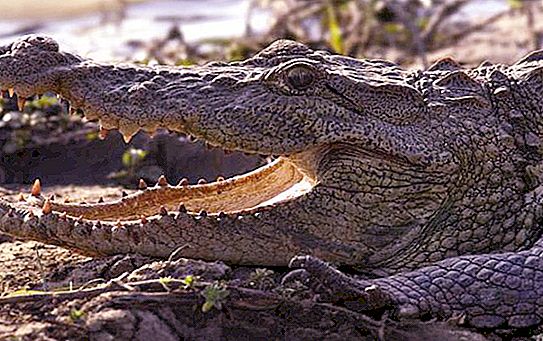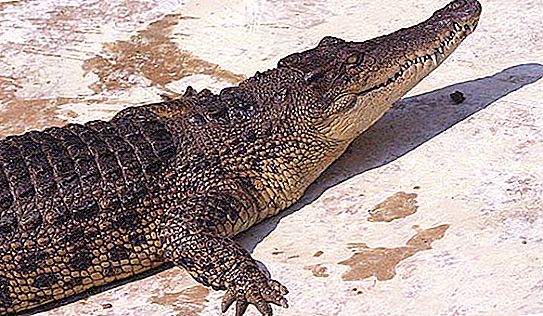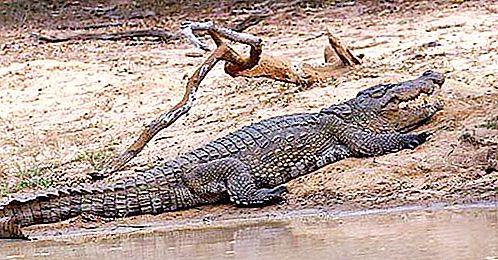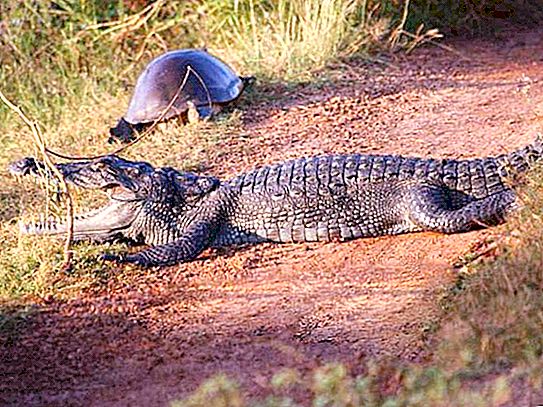Crocodiles are the oldest animals, the only surviving representatives of the subclass of Archosaurs - a group of reptiles, to which dinosaurs belonged. It is assumed that their history began about 250 million years ago in the early Triassic, if we talk about all crocodilomorphs. Representatives of the existing detachment appeared a little later - about 83.5 million years ago. Now they are common in all countries with a hot tropical climate. The Indian crocodile is one of three species that live in Hindustan and in the territory adjacent to it, reptiles. This is a fairly large predator with a characteristic appearance.
What does a swamp crocodile look like?

Marsh crocodile in literary sources can often be found under the name Mager, as well as Indian. Its appearance resembles the structure of an alligator. The rough head has wide and heavy jaws, their length exceeds 1.5-2.5 times the width at the base. Combs and outgrowths of scaly bones are absent. There are 4 large plates on the neck forming a square with smaller plates on each side. The dorsal are well separated from the occipital; osteoderms are usually located in four rows, sometimes in six. The central plates on the back can be wider than the side ones. Swamp crocodile (mager) is characterized by keeled scales on the limbs and fingers having membranes at the base. The color of individuals may vary slightly depending on age. Adult crocodiles, as a rule, have a dark olive color, and young crocodiles are light olive with black spots and dots.

Dimensions of the swamp crocodile
Taking into account the size of all representatives of the Crocodile order, it can be said with confidence that this species has average sizes. There is sexual dimorphism. Females with a length of about 2.45 m are slightly smaller than males, which reach from 3.2 to 3.5 m. The differences also apply to body weight. The predominant number of individuals of both sexes, both young and adult, by weight fit into the range from 40 to 200 kg. Females are smaller and reach up to 50-60 kg, males are much larger and heavier - up to 200-250 kg.
Swamp crocodile (males) at a very mature age can have impressive dimensions. Rarely, but still there are cases when they grow more than 4.5 m in length and gain weight up to 450 kg. The largest officially registered indicator is about 5 m and 600 kg, respectively.
Habitat

Marsh crocodile is not so named. His favorite place of residence is shallow ponds with stagnant or weakly flowing fresh water. These are mainly swamps, lakes, rivers and, less commonly, irrigation canals. Sometimes you can find swamp crocodile in lagoons with brackish water. Geographically, the species is common in India, Pakistan, Iraq, Sri Lanka, Myanmar, Iran, Bangladesh, Nepal.
The population in most areas is declining every year and is approaching a critical level. The main reason is the destruction of the natural habitat and the demographic problem of this region. India began to protect the swamp crocodile back in 1975, creating a special program to increase the number of species. The largest population (over 2000 individuals) is in Sri Lanka.
Swamp crocodile: nutrition and lifestyle
This species, like the Cuban crocodile, feels better on land than all the other representatives of the detachment. It can move (migrate) over short distances and even chase its prey on land for a short time, while developing a speed of more than 12 km / h, in its native environment (water) it rapidly increases to 30-40 km / h. In addition, wizards dig burrows on land in which they hide from the heat during a drought.
The basis of the diet of the Indian crocodile is fish, snakes, including pythons, birds, turtles, mammals of medium and small size (squirrels, otters, monkeys, deer, etc.). Large, adult individuals may well prey on ungulates: Asian antelopes, Indian zambars, buffalos and gauras. A marsh crocodile guards them at a watering place and, grabbing prey at the right moment, drags it under the water, where it then tears it to pieces. At night, they hunt on land along forest paths and can take prey from other predators, for example, from leopards.
Swamp crocodile uses a very interesting way of catching birds. This is one of the few reptiles that uses bait. He holds on its face small twigs and sticks that attract birds looking for building material for their nests. Tactics are especially relevant in the spring.
In general, the Indian crocodile is a social animal. They quite calmly tolerate each other's presence near bathing places, during feeding and hunting.
Interaction with other animals and humans

Adult marsh crocodile, in fact, are at the top of the food chain. Therefore, as a rule, they are not attacked by other predators. The competition for the species is only the larger in size and aggressive-combed crocodile. It prevents the settlement of the species in question and even sometimes preys on it.
Marsh crocodiles and tigers pose a certain danger to each other. As a rule, predators try to avoid meeting, but there were times when they entered into an open physical confrontation. A marsh crocodile poses a serious danger to a smaller leopard, which it attacks quite often.
Cases of predator attacks on humans periodically occur. It has a fairly large size, is aggressive and poses a certain threat to humans. However, it is not as dangerous as its related species: Nile and combed crocodiles.




